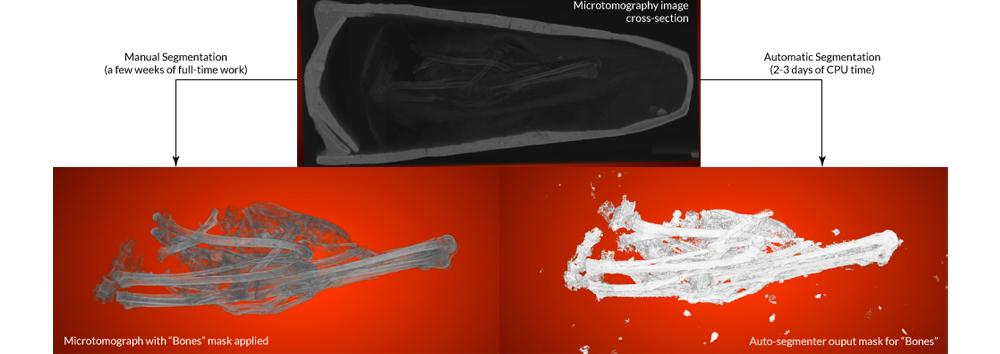What has the ATTRACT seed funding enabled you to do so far?
ATTRACT seed funding has allowed us to get the right group of people together to tackle the problem of automatically segmenting high-resolution CT scans of Egyptian mummies. We have already implemented a proof of concept algorithm, using engineered features and supervised machine learning, which allows us to segment a 17.1 Gpx volume in about 2 days. Manual segmentation of the same volume by experienced personnel took 3 weeks.
What challenges have you faced so far?
As in many multi-disciplinary problems, the first challenge is to bridge the gap between the disciplines, in this case between archaeology and computing. The size of the volumes (e.g. an ibis mummy has a 33GB footprint) also requires careful use of computational resources, and workstations with a relatively large primary memory. Fundamentally, it is often difficult to distinguish between certain components, such as soft tissue and dense textiles, particularly when these are impregnated with resin. Furthermore, ground truth data is unavailable; instead, we have been using manually segmented images for training, which are imperfect. This potentially reduces the effectiveness of training.
Where does your ATTRACT journey go from here?
We are currently working on a reference optimised implementation of our algorithm, which we intend to publish by the end of the funded project. This would facilitate the use of our technique by other groups, and with other data sets. Our recent presentation has attracted interest from groups facing related problems in paleontology, while the new BM18 beamline at ESRF-EBS also opens the possibility of scanning larger specimens and of working at multiple resolutions. Extending our approach to work with multi-scale volumes promises to improve its accuracy, but presents a step change in complexity. There are also a number of improvements that we would like to investigate, which should improve the quality of the segmentation, requiring less manual post-processing. All of this would be possible with additional funding, such as through the ATTRACT stage-2 proposal.
Sum up in two sentences the advantages of the ATTRACT Programme over other research funding schemes.
Unlike most research funding schemes, ATTRACT seed funding takes a positive view of speculative proposals, making it possible to fund bottom-up projects that have the potential to return a high reward if successful. Furthermore, ATTRACT management is lightweight, allowing the researchers to focus on the technical work, while still meeting the funding body requirements.
For more information
Visit the ASEMI project site.
©ASEMI What has the ATTRACT seed funding enabled you to do so far? ATTRACT seed funding has allowed us to get the right group of people together to tackle the problem of automatically segmenting high-resolution CT scans of Egyptian mummies. We have already implemented a proof of concept algorithm, using engineered features and supervised machine […]



